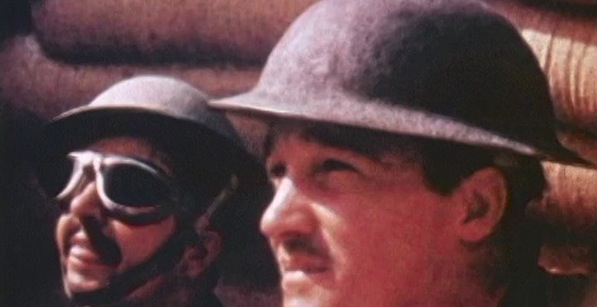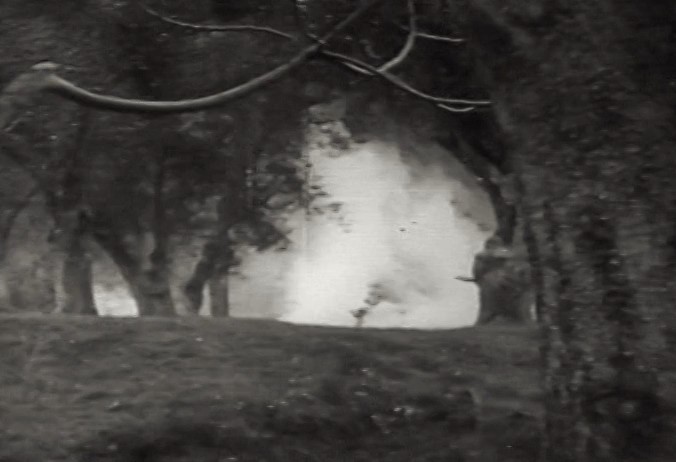Mark Harris’ portrait of the fighting individuals and testing circumstances of WWII breathes with life; it left me numb by the end. If you’re fascinated by cinema, history or just good writing, then this title ought to be on your shelf. The book delves extensively into the propaganda films and documentaries made during World War II, shedding light on their production while offering necessary critique as well. What follows are notes on five films Harris covers in the book.
[Editor’s note: This list accompanies the review “Harris’ WWII Hollywood: ‘Five Came Back‘”]
The Battle of Midway (1942)
“Forget the pictures as much as you can,” Captain Simard had said to John Ford before the Battle of Midway. He wanted the director to concentrate on just staying alive, a necessary warning since Ford had turned up on the Pacific island believing he only had to document life on a military base. He had shot footage of the flora and fauna, but tried to train his cameras on the battle once it unfolded, risking his life in the process. One bomb blew Ford off his feet with his camera still running—“its impact is visible on the film.”
The footage he obtained would lead to an eighteen-minute documentary, edited secretly in San Francisco by Robert Parrish, who had collaborated with Ford on How Green Was My Valley. Audiences back home had never seen actual warfare depicted like this, part of the reason Ford made narrator Irving Pichel say “Yes. This really happened.” at one point.
President Roosevelt, after seeing Midway, said, “I want every mother in America to see this film.” He got his wish, as the film played in seventy-five percent of American theaters at one point and went on to win the Academy’s first-ever “Best Documentary Short” prize.
The Battle of San Pietro (1945)
For decades, it has been said that filmmaker John Huston and his crew shot this film while attached to the 143rd Regiment. It has been believed that the cameraman were in just as much danger as the soldiers, leading to the film’s unflinching realism.
Five Came Back blows the lid off these myths. He serves a powerful put-down to Huston’s lies and exaggeration, claiming that the director released the film with false claims. “When guns were fired or shells exploded, he made sure the image jolted as if the ground had shaken or the cameraman had been taken by surprise,” writes Harris.
Nevertheless, San Pietro’s brutal portrayal of battle—staged or otherwise—makes it important viewing. It has scenes depicting close-up views of the faces of dead soldiers as they are loaded into body bags, leading the War Department to complain the film was anti-war. Huston replied that if he ever made a pro-war film, he should be shot.
The Memphis Belle: A Story of a Flying Fortress (1944)
This documentary, directed by William Wyler, provides an account of the final mission of the crew of a Boeing B-17 Flying Fortress named “Memphis Belle.” Years later, Wyler’s biographer asked Captain Charles Leighton about the experience of having a director onboard the crew. Leighton replied, “Coming along with us just for pictures? The guy had guts.”
For the purpose of this documentary, Wyler attended gunnery school, where he learned how to “take a machine gun apart and put it back in sixty-degree-below-zero weather.” He took wheel’s-eye view footage of the Belle’s takeoff and descent, leading some men to believe he was crazy for trying.
Memphis Belle is a thrill to watch even today, with Eugene Kern’s stern narration overseeing the magnificent aerial footage. The first film ever to be reviewed on the front page of The New York Times, the film came with President Roosevelt’s strong recommendation. “This has to be shown right away, everywhere,” he said to Wyler after seeing the film.
The Why We Fight series (1942-1945)
As soon as USA entered World War II, the Army desperately needed a set of factual training films they could screen for inducted GIs, elucidating why the war was being fought and why the enemy needed to be defeated. They turned to Frank Capra for the same, because “of his commitment to American ideals.”
Capra was heavily intimidated—and influenced—by Leni Riefenstahl’s Nazi propaganda film, Triumph of the Will, after seeing which he thought, “Satan couldn’t have devised a more blood-chilling super-spectacle.” He cannily reused footage from Triumph and other Nazi-shot footage from the era, plastering narration over them to make his point.
The “signal filmmaking accomplishment” from the war, the “Why We Fight” series also remains the most well-known of all American WWII propaganda films. At least fifty-four million people had seen an episode from the series by the war’s end. The first entry, Prelude to War¸ won the Academy Award for Best Documentary Feature in 1943 and Capra’s work during the War netted him a Distinguished Service Medal.
Report from the Aleutians (1943)
The first documentary John Huston made from the battlefront is completely different from The Battle of San Pietro.
A forty-seven-minute propaganda film about the Aleutian Islands Campaign, Report is remarkable because of how little combat footage it features. It is unique among all films mentioned so far because of the emphasis it places on the humdrum routine of the corps stationed at far-off places. In fact, one of the livelier moments in the film is the soldiers gathering to receive their mail; Report is more interested in showing the monotony of Army life, epitomized by images of latrine digging.
During filming, Huston was considered a bad omen to be on a plane, so much that he became known as a Jonah. But, long before the aerial footage (finally) arrives and long after it ends, Report stays on in a viewer’s memory because of its accuracy and insight.








